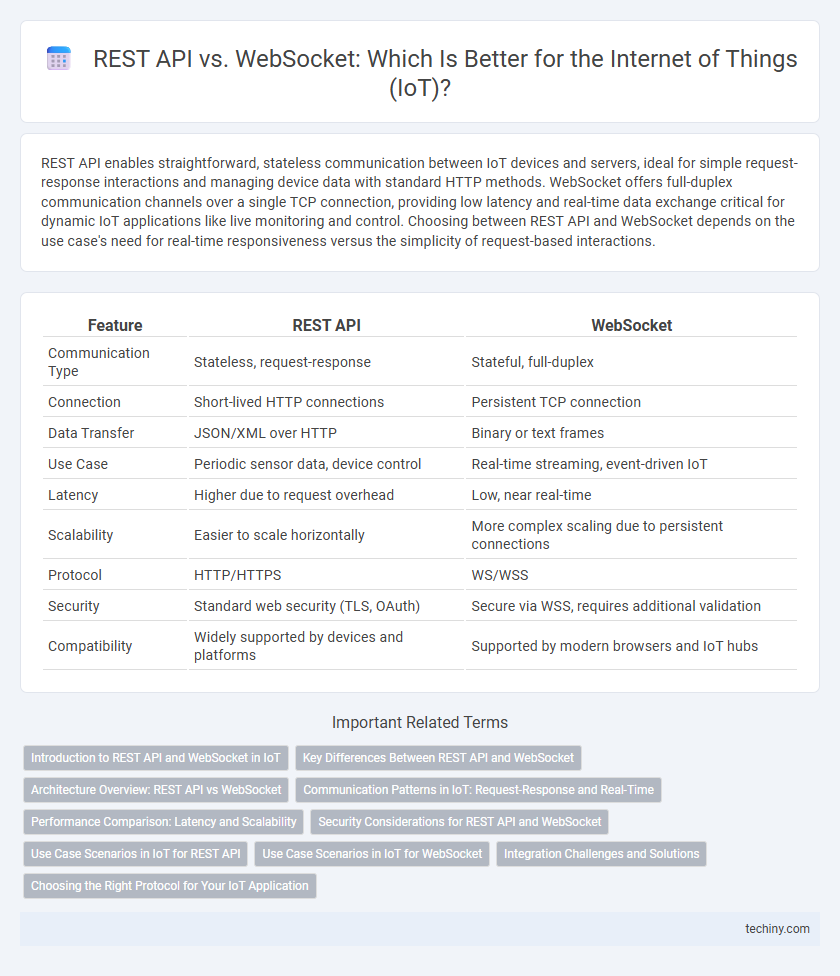REST API enables straightforward, stateless communication between IoT devices and servers, ideal for simple request-response interactions and managing device data with standard HTTP methods. WebSocket offers full-duplex communication channels over a single TCP connection, providing low latency and real-time data exchange critical for dynamic IoT applications like live monitoring and control. Choosing between REST API and WebSocket depends on the use case's need for real-time responsiveness versus the simplicity of request-based interactions.
Table of Comparison
| Feature | REST API | WebSocket |
|---|---|---|
| Communication Type | Stateless, request-response | Stateful, full-duplex |
| Connection | Short-lived HTTP connections | Persistent TCP connection |
| Data Transfer | JSON/XML over HTTP | Binary or text frames |
| Use Case | Periodic sensor data, device control | Real-time streaming, event-driven IoT |
| Latency | Higher due to request overhead | Low, near real-time |
| Scalability | Easier to scale horizontally | More complex scaling due to persistent connections |
| Protocol | HTTP/HTTPS | WS/WSS |
| Security | Standard web security (TLS, OAuth) | Secure via WSS, requires additional validation |
| Compatibility | Widely supported by devices and platforms | Supported by modern browsers and IoT hubs |
Introduction to REST API and WebSocket in IoT
REST API enables IoT devices to communicate through stateless HTTP protocols, facilitating scalable and interoperable data exchange by using standard methods like GET, POST, PUT, and DELETE. WebSocket provides full-duplex communication channels over a single TCP connection, allowing real-time, bidirectional data transfer critical for time-sensitive IoT applications such as monitoring and control systems. Choosing between REST API and WebSocket depends on the specific IoT use case requirements for latency, data frequency, and network efficiency.
Key Differences Between REST API and WebSocket
REST API operates on a request-response model, making it suitable for stateless communication and occasional data exchange in IoT devices, while WebSocket provides full-duplex communication enabling real-time, bidirectional data streaming essential for continuous monitoring and control. REST API uses HTTP methods like GET, POST, PUT, and DELETE to interact with resources, whereas WebSocket establishes a persistent connection allowing instant data transfer without repeated HTTP handshakes. The key differences lie in communication patterns, latency, and resource efficiency, with WebSocket excelling in scenarios requiring low latency and persistent connectivity, in contrast to REST API's scalability and simplicity for less time-sensitive IoT applications.
Architecture Overview: REST API vs WebSocket
REST API architecture relies on stateless, request-response communication over HTTP, enabling scalable IoT interactions with simple CRUD operations. WebSocket architecture establishes a persistent, full-duplex connection, facilitating real-time, bidirectional data exchange essential for latency-sensitive IoT applications. The choice between REST API and WebSocket depends on the specific IoT use case requirements for communication frequency, latency, and resource consumption.
Communication Patterns in IoT: Request-Response and Real-Time
REST API in IoT primarily supports a request-response communication pattern, making it ideal for occasional data retrieval or command execution where latency is less critical. WebSocket enables persistent, full-duplex communication channels suited for real-time data transmission and continuous device monitoring, essential in time-sensitive IoT applications. Choosing between REST API and WebSocket depends on the specific IoT use case requirements for latency, data volume, and interaction frequency.
Performance Comparison: Latency and Scalability
REST API exhibits higher latency compared to WebSocket due to its stateless request-response model, making it less suitable for real-time IoT applications requiring low-latency communication. WebSocket provides persistent, full-duplex connections that significantly reduce latency and improve scalability by enabling simultaneous data streams between IoT devices and servers. Scalability in WebSocket facilitates efficient management of numerous connected IoT endpoints, optimizing network resource utilization and enhancing overall system performance.
Security Considerations for REST API and WebSocket
REST API security relies heavily on stateless authentication methods such as OAuth 2.0 and token-based access controls to prevent unauthorized data access in IoT environments. WebSocket security focuses on protocol-level protections including Secure WebSocket (wss://) encryption and origin validation to mitigate risks like man-in-the-middle attacks and cross-site WebSocket hijacking. Both communication methods require robust rate limiting, input validation, and monitoring to defend against denial-of-service attacks and ensure secure data transmission in Internet of Things applications.
Use Case Scenarios in IoT for REST API
REST API in IoT excels in scenarios requiring stateless communication and resource manipulation, such as device configuration management and telemetry data fetching. Its request-response model supports periodic sensor data updates and remote device control where timing is not critical. REST APIs are ideal for integrating heterogeneous IoT devices with cloud platforms, enabling scalable and interoperable management in smart home, industrial automation, and environmental monitoring systems.
Use Case Scenarios in IoT for WebSocket
WebSocket is ideal for IoT applications requiring real-time, bidirectional communication, such as remote monitoring of industrial equipment or smart home automation systems. It supports continuous data flow with low latency, enabling instant device status updates and command execution. This makes WebSocket particularly effective for scenarios involving frequent sensor data streaming or interactive control interfaces.
Integration Challenges and Solutions
REST API in IoT integration faces challenges such as stateless communication and higher latency, limiting real-time data exchange efficiency. WebSocket overcomes these issues by enabling full-duplex, persistent connections that facilitate instant bi-directional communication. To address integration complexities, hybrid architectures combining REST for configuration and WebSocket for live data streams improve scalability and responsiveness in IoT networks.
Choosing the Right Protocol for Your IoT Application
REST API offers simplicity and stateless communication ideal for IoT applications requiring infrequent data exchange and strong scalability. WebSocket provides full-duplex communication essential for real-time IoT applications needing continuous data streams and low latency. Selecting the right protocol depends on specific IoT use cases, data transmission frequency, and latency sensitivity.
REST API vs WebSocket Infographic

 techiny.com
techiny.com